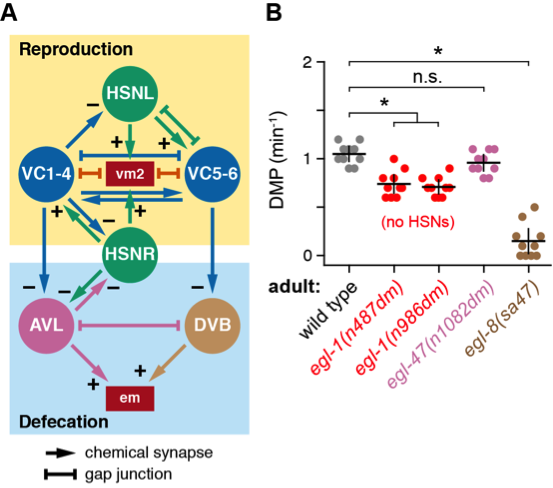Description
In our accompanying paper, we show that Ca2+ activity in the HSN egg-laying command motor neurons is associated with a delay in the frequency defecation motor program (DMP) in both late L4 juveniles and egg-laying adults (Ravi and Collins 2019). While optogenetic activation of the HSNs did not directly reduce the frequency of defecation, egg-laying adults did show a significant reduction in defecation frequency compared to younger animals, consistent with previous results (Bolanowski et al. 1981). As shown in Figure 1A, the egg-laying and defecation circuits are interconnected. The HSN command neurons and VC motor neurons that synapse onto the egg-laying vulval muscles also make and receive synapses from the excitatory GABAergic AVL and DVB motoneurons that innervate the enteric muscles that regulate defecation. We test the functional relationship between egg-laying and defecation behaviors, we measured DMP frequency in animals with altered HSN neurotransmitter signaling. We hypothesized that mutations that reduce HSN neurotransmitter signaling would increase DMP frequency because periods of elevated HSN Ca2+ activity were associated with decreased DMP frequency (Ravi and Collins 2019). Surprisingly, animals bearing two independent egl-1(dm) mutants that cause the HSNs to undergo premature cell death showed a decrease in DMP frequency (Figure 1B). While this delay was significant, it was mild compared to egl-8(sa47) null mutants that eliminate PLCβ and IP3 signaling required for proper timing of the defecation motor program (Dal Santo et al. 1999; Lackner et al. 1999). These results show the HSNs are required for a normal DMP rhythm in adult animals. Interestingly, this delay in defecation frequency in HSN-deficient animals was not observed in egl-47(dm) mutant animals with strong defects in HSN neurotransmitter release and similar defects in egg-laying behavior as egl-1(dm) mutants (Moresco and Koelle 2004). We do not believe this egl-1(dm)-specific defect in defecation is caused by differences in bloating in response to egg accumulation in the uterus, as both mutants retain an indistinguishable number of embryos (Moresco and Koelle 2004) and show similar delays in the onset of egg laying (Ravi et al. 2018). Further, egl-47(dm) animals still have HSNs (Moresco and Koelle 2004) and show occasional HSN Ca2+ transients, so the reduced DMP frequency in egl-1(dm) animals suggests the HSNs are developmentally required for a normal DMP rhythm and/or that even low levels of serotonin or NLP-3 neuropeptide release from HSN are sufficient for a normal defecation rhythm (Brewer et al. 2019). We propose that animals coordinate egg-laying and defecation behaviors to direct changes in hydrostatic pressure used to drive expulsion of uterine or intestinal contents, but that HSN signaling is still required for full coordination of these behaviors. Consistent with this hypothesis, a common set of signaling molecules regulate activity of circuits that modulate egg-laying and defecation behaviors (Reiner et al. 1995).
Reagents
Strains available from CGC: Bristol N2, MT1082 egl-1(n487dm) V; MT2248 egl-47(n1081dm) V; and JT47 egl-8(sa47) V. Strain available upon request: MIA26 egl-1(n986dm) V. DMP frequency was measured based on the timing of the final expulsion step in animals staged 24 hours after the late L4 stage (Liu and Thomas 1994).
References
Funding
The authors acknowledge support from NIH grant R01-NS086932 and R25-GM076419.
Reviewed By
Niels RingstadHistory
Received: March 23, 2019Accepted: March 28, 2019
Published: March 29, 2019
Copyright
© 2019 by the authors. This is an open-access article distributed under the terms of the Creative Commons Attribution 4.0 International (CC BY 4.0) License, which permits unrestricted use, distribution, and reproduction in any medium, provided the original author and source are credited.Citation
Garcia, J; Collins, KM (2019). The HSN egg-laying command neurons are required for normal defecation frequency in Caenorhabditis elegans (II). microPublication Biology. 10.17912/10.17912/micropub.biology.000094.Download: RIS BibTeX




